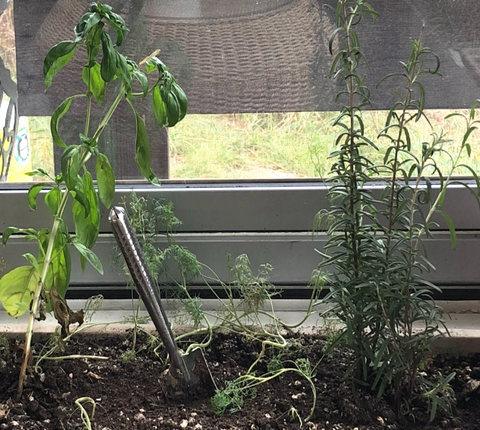Growing Indoor Herbs
For millennia, herbs have been enjoyed for their aromatic, culinary and medicinal properties. Indoor herbs make a great addition to your home. Here’s how to grow and care for your own.
Common Herbs
- Annual: basil, borage, chamomile, chervil, cilantro/coriander, dill, fennel, lemon balm, marjoram, stevia
- Perennial: chives, ginger, mint, oregano, lavender, sage, rosemary, thyme, parsley (biennial)

Basil (left), dill (center), and Rosemary (right).
How to Grow Indoor Herbs
From Seed
Growing herbs from seeds is the cheapest way to grow herbs.
- Fill a pot or tray with Jocelyn's Soil Booster Potting Soil. Remember to choose soil according to your herbs soil needs.
- Sprinkle seeds, cover lightly with soil and press down. Add a sprinkle of Jocelyn’s Soil Booster Worm Manure to give seeds a much needed nutrient boost.
- Spray the surface with water to moisten the soil and settle the seeds.
- Cover the surface with plastic wrap, a plastic bag or a dome to keep the seeds humid. Place the container near a sunny window.
- Remove the cover when seedlings emerge and allow them to grow up to 5 cm tall.
- Once the seedlings hit 5 cm, transplant into individual pots to allow for maximum growth.
From Transplants/Seedlings
Here’s how:
- Select plants that are not droopy, have normal colouring, and appear overall healthy.
- Fill a pot halfway with soil and mix in worm manure to give your newly transplanted herbs a much needed nutrient boost.
- Carefully remove your plant from its pot and separate individual plants. Gently tear away the base of the root ball to open the roots and accelerate root growth.
- Place your plant in the pot and cover the roots with soil.
- Water generously.
From Cuttings
A popular way to grow herbs is to propagate them from cuttings. Mint, basil, rosemary, and lavender are known to grow well from cuttings. Here are the steps:
- Cut a healthy, green stem 7-10 cm from the top of the plant with a clean tool just below a leaf node.
- Remove the bottom leaves and place the cutting in a glass of water. Leave on a sunny window sill. Change the water every few days. Optional: add root growth hormone to promote root growth.
- When roots are visible, transplant the cutting into a pot of soil.
- Add worm manure to boost nutrients and water generously.
Transplanting Indoors from Outdoors
If you, like me, live in an area with cold, snowy winters and want to prolong the lives of your outdoor herbs, you can transplant them into a pot inside. Here’s how:
- Inspect your outdoor herbs for pests. Spray foliage with water to knock off any pests.
- Dig up your plant before the ground freezes and transplant to a pot as described in the earlier section about growing herbs from transplants.
- Acclimate your herbs to indoor conditions by storing them in a cool spot with indirect light for approximately 1 week, then move them into direct sunlight. Quarantine them away from any other indoor plants to keep pests from spreading.
- Add worm manure to help the plant adjust to the new growing conditions.
Pruning
Pruning your herbs will make them grow bushier and allow you to get more out of your plants.
- Begin pruning when your herbs have several sets of healthy leaves.
- Use a sharp, clean, sterile tool such as garden snips or scissors and make a clean cut around ¼ inch (0.6 cm) above a healthy set of leaves. Cutting tools can be sterilized using rubbing alcohol or flame.
More Tips
- Snip flower buds off herbs to prolong their life cycle.
- Herbs typically do not get pests because of their aromatic properties. Any pests that do get on the plants can be dealt with using insect soap or 70% rubbing alcohol.
May you always have the delight of fresh herbs in your home!

